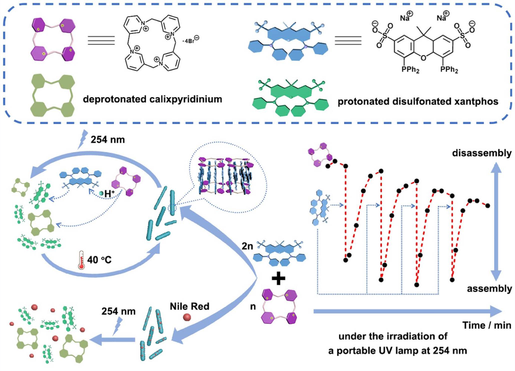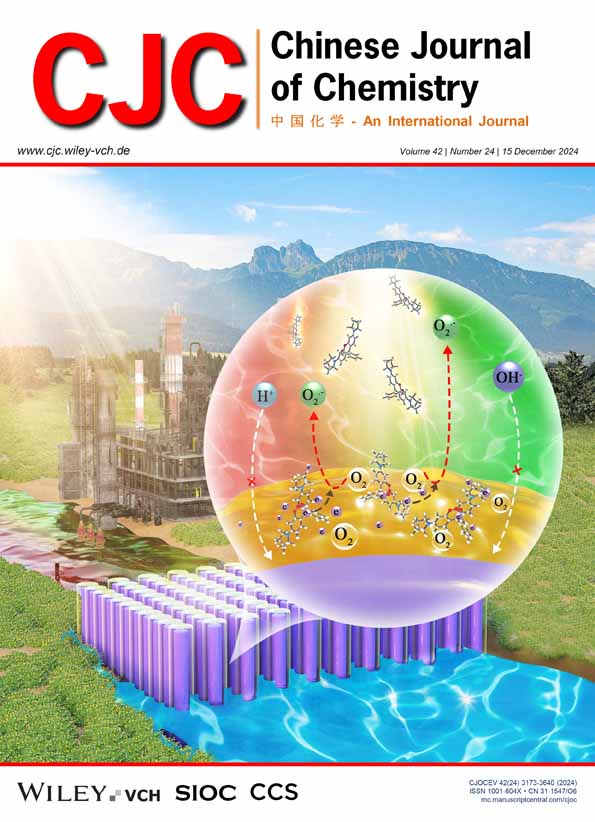Macrocyclic Calixpyridinium as a Photoacid for the Construction of Photoresponsive Supramolecular Materials
Corresponding Author
Kui Wang
Tianjin Key Laboratory of Structure and Performance for Functional Molecules, College of Chemistry, Tianjin Normal University, Tianjin, 300387 China
E-mail: [email protected]Search for more papers by this authorSi-Chen Liu
Tianjin Key Laboratory of Structure and Performance for Functional Molecules, College of Chemistry, Tianjin Normal University, Tianjin, 300387 China
Search for more papers by this authorYu-Ting Wang
Tianjin Key Laboratory of Structure and Performance for Functional Molecules, College of Chemistry, Tianjin Normal University, Tianjin, 300387 China
Search for more papers by this authorXin Meng
Tianjin Key Laboratory of Structure and Performance for Functional Molecules, College of Chemistry, Tianjin Normal University, Tianjin, 300387 China
Search for more papers by this authorJian-Wen Wei
Tianjin Key Laboratory of Structure and Performance for Functional Molecules, College of Chemistry, Tianjin Normal University, Tianjin, 300387 China
Search for more papers by this authorXin Yan
Tianjin Key Laboratory of Structure and Performance for Functional Molecules, College of Chemistry, Tianjin Normal University, Tianjin, 300387 China
Search for more papers by this authorCorresponding Author
Kui Wang
Tianjin Key Laboratory of Structure and Performance for Functional Molecules, College of Chemistry, Tianjin Normal University, Tianjin, 300387 China
E-mail: [email protected]Search for more papers by this authorSi-Chen Liu
Tianjin Key Laboratory of Structure and Performance for Functional Molecules, College of Chemistry, Tianjin Normal University, Tianjin, 300387 China
Search for more papers by this authorYu-Ting Wang
Tianjin Key Laboratory of Structure and Performance for Functional Molecules, College of Chemistry, Tianjin Normal University, Tianjin, 300387 China
Search for more papers by this authorXin Meng
Tianjin Key Laboratory of Structure and Performance for Functional Molecules, College of Chemistry, Tianjin Normal University, Tianjin, 300387 China
Search for more papers by this authorJian-Wen Wei
Tianjin Key Laboratory of Structure and Performance for Functional Molecules, College of Chemistry, Tianjin Normal University, Tianjin, 300387 China
Search for more papers by this authorXin Yan
Tianjin Key Laboratory of Structure and Performance for Functional Molecules, College of Chemistry, Tianjin Normal University, Tianjin, 300387 China
Search for more papers by this authorComprehensive Summary
pH is an important stimuli-responsive signal because deprotonation-protonation process is crucial for many life functions. Photoacid is a kind of photoresponsive group that can release protons upon irradiation. This property makes invasive pH control can be replaced by noninvasive light control. However, photoacid is rare. In this work, macrocyclic calixpyridinium was found to be used as a photoacid to release protons from acidic methylene under the irradiation of a 254 nm UV lamp. When the solution of calixpyridinium−disulfonated xantphos aggregates were irradiated by a 254 nm portable UV lamp, disulfonated xantphos was able to receive the protons released from calixpyridinium. This noninvasive photocontrolled proton transfer not only replaces an invasive pH regulation but also achieves a synergistic function. The deprotonation of calixpyridinium and the protonation of disulfonated xantphos can occur simultaneously to disrupt the aggregates. Moreover, the photoresponsive disassembly is reversible by heating. This photoresponsive material was further applied as a photocontrolled release model. In addition, a dissipative assembly was successfully designed based on this photoresponsive disassembly. This study supplies a generalized strategy to construct pH-responsive biocompatible materials with light-control properties by using macrocyclic calixpyridinium and its matched various guests in water.

Supporting Information
| Filename | Description |
|---|---|
| cjoc202400821-sup-0001-supinfo.pdfPDF document, 1.1 MB |
Appendix S1: Supporting Information |
Please note: The publisher is not responsible for the content or functionality of any supporting information supplied by the authors. Any queries (other than missing content) should be directed to the corresponding author for the article.
References
- 1 Kumar, R.; Sharma, A.; Singh, H.; Suating, P.; Kim, H. S.; Sunwoo, K.; Shim, I.; Gibb, B. C.; Kim, J. S. Revisiting Fluorescent Calixarenes: From Molecular Sensors to Smart Materials. Chem. Rev. 2019, 119, 9657−9721.
- 2 Ma, X.; Tian, H. Stimuli-Responsive Supramolecular Polymers in Aqueous Solution. Acc. Chem. Res. 2014, 47, 1971−1981.
- 3 Zhang, H.; Liu, Z.; Zhao, Y. Pillararene-based self-assembled amphiphiles. Chem. Soc. Rev. 2018, 47, 5491−5528.
- 4 Liu, Z.; Lin, W.; Liu, Y. Macrocyclic Supramolecular Assemblies Based on Hyaluronic Acid and Their Biological Applications. Acc. Chem. Res. 2022, 55, 3417−3429.
- 5 Frisch, H.; Besenius, P. pH-Switchable Self-Assembled Materials. Macromol. Rapid Commun. 2015, 36, 346−363.
- 6 Yang, C.; Khalil, T.; Liao, Y. Photocontrolled proton transfer in solution and polymers using a novel photoacid with strong C–H acidity. RSC Adv. 2016, 6, 85420−85426.
- 7 Wu, L.; Jiang, X. Proton Transfer at Interaction Interface of Graphene Oxide. Anal. Chem. 2018, 90, 10223−10230.
- 8 Jansze, S. M.; Cecot, G.; Severin, K. Reversible disassembly of metallasupramolecular structures mediated by a metastable-state photoacid. Chem. Sci. 2018, 9, 4253−4257.
- 9 Rizzuto, F. J.; Platnich, C. M.; Luo, X.; Shen, Y.; Dore, M. D.; Lachance-Brais, C.; Guarné, A.; Cosa, G.; Sleiman, H. F. A dissipative pathway for the structural evolution of DNA fibres. Nat. Chem. 2021, 13, 843−849.
- 10 Ragazzon, G.; Baroncini, M.; Silvi, S.; Venturi, M.; Credi, A. Light- powered autonomous and directional molecular motion of a dissipative self-assembling system. Nat. Nanotechnol. 2015, 10, 70−75.
- 11 Shi, Z.-T.; Hu, Y.-X.; Hu, Z.; Zhang, Q.; Chen, S.-Y.; Chen, M.; Yu, J.-J.; Yin, G.-Q.; Sun, H.; Xu, L.; Li, X.; Feringa, B. L.; Yang, H.-B.; Tian, H.; Qu, D.-H. Visible-Light-Driven Rotation of Molecular Motors in Discrete Supramolecular Metallacycles. J. Am. Chem. Soc. 2021, 143, 442−452.
- 12 Xu, F.; Pfeifer, L.; Crespi, S.; Leung, F. K.-C.; Stuart, M. C. A.; Wezenberg, S. J.; Feringa, B. L. From Photoinduced Supramolecular Polymerization to Responsive Organogels. J. Am. Chem. Soc. 2021, 143, 5990−5997.
- 13 Chen, X.-M.; Hou, X.-F.; Bisoyi, H. K.; Feng, W.-J.; Cao, Q.; Huang, S.; Yang, H.; Chen, D.; Li, Q. Light-fueled transient supramolecular assemblies in water as fluorescence modulators. Nat. Commun. 2021, 12, 4993.
- 14 Chen, S.; Costil, R.; Leung, F. K.-C.; Feringa, B. L. Self-Assembly of Photoresponsive Molecular Amphiphiles in Aqueous Media. Angew. Chem. Int. Ed. 2021, 60, 11604−11627.
- 15 Otolski, C. J.; Raj, A. M.; Ramamurthy, V.; Elles, C. G. Spatial confinement alters the ultrafast photoisomerization dynamics of azobenzenes. Chem. Sci. 2020, 11, 9513−9523.
- 16 Villarón, D.; Wezenberg, S. J. Stiff-Stilbene Photoswitches: From Fundamental Studies to Emergent Applications. Angew. Chem. Int. Ed. 2020, 59, 13192−13202.
- 17 Fukushima, T.; Tamaki, K.; Isobe, A.; Hirose, T.; Shimizu, N.; Takagi, H.; Haruki, R.; Adachi, S.; Hollamby, M. J.; Yagai, S. Diarylethene-Powered Light-Induced Folding of Supramolecular Polymers. J. Am. Chem. Soc. 2021, 143, 5845−5854.
- 18 Wu, Z.; Zhang, L. Photoregulation between small DNAs and reversible photochromic molecules. Biomater. Sci. 2019, 7, 4944−4962.
- 19 Abeyrathna, N.; Liao, Y. A Reversible Photoacid Functioning in PBS Buffer under Visible Light. J. Am. Chem. Soc. 2015, 137, 11282−11284.
- 20 Kaiser, C.; Halbritter, T.; Heckel, A.; Wachtveitl, J. Proton-transfer Dynamics of Photoacidic Merocyanines in Aqueous Solution. Chem. Eur. J. 2021, 27, 9160−9173.
- 21 Kortekaas, L.; Browne, W. R. The evolution of spiropyran: fundamentals and progress of an extraordinarily versatile photochrome. Chem. Soc. Rev. 2019, 48, 3406−3424.
- 22 Zhang, H.; Zeng, H.; Priimagi, A.; Ikkala, O. Programmable responsive hydrogels inspired by classical conditioning algorithm. Nat. Commun. 2019, 10, 3267.
- 23 Périllat, V. J.; Berton, C.; Pezzato, C. The effect of temperature on the photoacidity of merocyanine photoacids in water. Mater. Today Chem. 2022, 25, 100918.
- 24 Wimberger, L.; Prasad, S. K. K.; Peeks, M. D.; Andréasson, J.; Schmidt, T. W.; Beves, J. E. Large, Tunable, and Reversible pH Changes by Merocyanine Photoacids. J. Am. Chem. Soc. 2021, 143, 20758−20768.
- 25 Moreno, S.; Sharan, P.; Engelke, J.; Gumz, H.; Boye, S.; Oertel, U.; Wang, P.; Banerjee, S.; Klajn, R.; Voit, B.; Lederer, A.; Appelhans, D. Light-Driven Proton Transfer for Cyclic and Temporal Switching of Enzymatic Nanoreactors. Small 2020, 16, 2002135.
- 26 Shinoda, S.; Tadokoro, M.; Tsukube, H.; Arakawa, R. One-step synthesis of a quaternary tetrapyridinium macrocycle as a new specific receptor of tri-carboxylate anions. Chem. Commun. 1998, 181−182.
- 27 Wang, K.; Meng, X.; Zhang, X.-J. Water-soluble multifunctional red luminescent materials constructed by macrocycle–ligand–lanthanide synergetic assembly strategy. Mater. Today Chem. 2022, 26, 101232.
- 28 Wang, K.; Liu, S.-C.; Gao, G.-J.; Xing, S.; Zhu, B. Light-Responsive Fluorescent Security Ink Based on Calixpyridinium−Protoporphyrin IX Disodium Salt Supramolecular Nanoassemblies. ACS Appl. Nano Mater. 2023, 6, 12248−12257.
- 29 Yu, X.; Ren, X.; Wang, M.; Wang, K.; Zhang, D. Evaluation of biosafety/biocompatibility of calixpyridinium on different cell lines. J. Inclusion Phenom. Macrocyclic Chem. 2021, 99, 109−115.
- 30 Wang, K.; Gao, G.-J.; Wang, X.-Y. Photooxidation of IR-820 by Calixpyridinium-Induced Assembled Material and Its pH-Controlled Visual Multicolor Luminescence. Chin. J. Chem. 2022, 40, 1045−1052.
- 31 Wang, K.; Wang, Q.-Q.; Wang, M.-N.; Xie, Y.-J.; Qiao, X.; Xing, S.; Zhu, B. A pH-dependent fluorescent and colouring macrocycle for the high selective detection of arginine in pure water. Dyes Pigm. 2021, 188, 109203.




